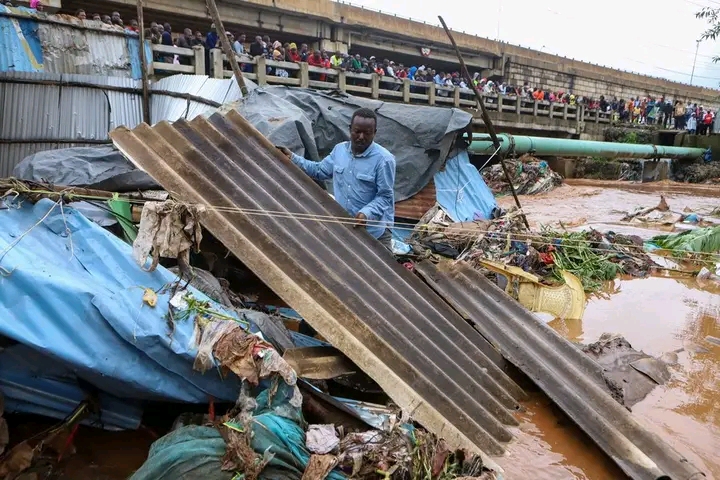Nairobi,
Sunday, 28 April, 2024
McCreadie Andias
The adversity
Flooding and heavy rains in Kenya have killed at least 70 people since mid-March, according to the government spokesperson Dr.Isaac Mwaura , the number being twice as many as that reported earlier this week and the number is expected to increase as flooding continues across the country.
“The official tally of fellow Kenyans who regrettably have lost their lives due to the flooding situation now stands at 70 lives,” government spokesperson Isaac Mwaura said on X on Friday, after torrential rains killed 32 people in the capital Nairobi this week.
Some parts of Nairobi remained underwater on Thursday, and Kenyans were warned to stay alert, with the forecast for more heavy rains across the country in coming days.
In the Mathare neighborhood, at least four bodies were retrieved from flooded houses on Wednesday from the Mathare River.
Fifteen people were killed in the Rift Valley region, the government also said in a report on Friday, following a meeting of the country’s disaster response committee.
Kenya and other countries in East Africa — a region highly vulnerable to climate change — have been lashed by severe downpours in recent weeks.
President William Ruto chaired a multi-agency flood response meeting on Thursday and directed the National Youth Service to provide land for people in flood-affected areas.
Deputy President Rigathi Gachagua told a press briefing that people affected by the floods would be given food and other goods, while those living in the most vulnerable areas would be relocated.
More than 120,000 people have been displaced by the floods, a government report said, with 22 others injured and eight reported missing.
The government has proposed Ksh. 3.3 billion ( for an “initial emergency response”, which includes repairing infrastructure, emergency housing and food assistance.
Sixty-four public schools in Nairobi – nearly a third of the total number in the capital – have been “substantially affected” by the flooding, said Belio Kipsang, the principal secretary for education.
However, Deputy President Rigathi Gachagua said that “the schools will reopen as scheduled” following the mid-term holidays this month.
Major airports including the Jomo Kenyatta International Airport has been damaged by floods with the airport reporting that it’s Tower Avenue underpass was flooded and damaged in the wake of Saturday’s torrential rains compelling the airport to provide passage through it’s main avenue while some of its critical facilities remain damaged with leaking roofs.
Generally, The East African region has been pounded by heavier-than-usual rainfall during the current rainy season, with flooding also reported in neighboring Burundi where about 96,000 people have been displaced by months of relentless rains, the United Nations and the government said this month.
Meanwhile, Tanzania has experienced the worst flood impacts in the region so far with More than 200,000 people and 51,000 households affected by the rains with about 155 people killed and 236 others injured as reported by prime minister Kassim Majaliwa . Flooded schools were closed and emergency services were rescuing people marooned by the floodwaters.
Majaliwa told Parliament that the El Nino climate pattern has worsened the ongoing rainy season, causing flooding and destroying roads, bridges and railways.
“The heavy El Nino rains, accompanied by strong winds, floods and landslides in various parts of the country, have caused significant damage,” Majaliwa told Parliament on Thursday.
He warned those living in low-lying areas to move to higher ground and urged district officials to ensure that provisions meant for those whose homes were washed away go to those in need of the supplies.
The UN’s humanitarian agency (OCHA) said in an update this week that in Somalia, the seasonal Gu rains from April to June are intensifying, with flash floods reported since April 19.
It said four people had been reportedly killed and more than 800 people were affected or displaced nationwide.
Uganda has also suffered heavy storms that have caused riverbanks to burst, with two fatalities confirmed and several hundred villagers displaced.
Late last year, more than 300 people died in torrential rains and floods in Kenya, Somalia and Ethiopia, just as the region was trying to recover from its worst drought in four decades that left millions of people hungry.
But why are these numbers going up despite the frequency and predictability of the disasters? One would say once bitten twice shy but this is not the case across the east African region where floods continue to raise havoc over the years and the post – disaster impacts be it communicable diseases are lingering.
The flooding has been compounded by the El Nino weather pattern which by now should have prompted the local governments to establish a disaster risk reduction plan that will help not only to prevent or mitigate the impacts of disaster but also to prepare for them.
Disaster risk reduction (DRR) strategies are crucial for mitigating the adverse impacts of flooding in the East African region prone to recurrent floods due to adversities of climate change, deforestation, rapid urbanization, and inadequate or stable infrastructure.
How effective disaster risk reduction measures can be implemented to minimize the devastating effects of flooding
Firstly, investing in early warning systems (EWS) is paramount in reducing the impacts of flooding. EWS can provide timely information to communities, government agencies, and relevant stakeholders, allowing them to take proactive measures such as evacuation, relocation, and asset protection. These systems can utilize a combination of technologies including meteorological data, satellite imagery, and community-based monitoring to forecast floods accurately. By enhancing the accessibility and effectiveness of EWS, vulnerable populations can be better prepared to respond to impending flood events, thereby reducing casualties and property damage.
Secondly, improving land-use planning and zoning regulations can significantly mitigate flood risks in the region . Uncontrolled urbanization often results in the encroachment of settlements into flood-prone areas like informal settlements , exacerbating the vulnerability of communities to inundation, this can be seen with the striking impacts in Mathare. By enforcing strict zoning laws and land-use regulations, authorities can prevent the construction of infrastructure and settlements in high-risk zones. Additionally, promoting sustainable land management practices such as afforestation, wetland restoration, and soil conservation can help mitigate the impacts of flooding by enhancing natural drainage systems and reducing surface runoff.
Furthermore, enhancing infrastructure resilience is essential for minimizing the impacts of flooding in Kenya. This includes the construction and maintenance of robust flood defense systems such as levees, embankments, and drainage channels especially in urban areas like Nairobi which can be exacerbated by excess downpour leading to flooding. Investing in resilient infrastructure not only protects lives and property but also ensures the continuity of essential services such as transportation, water supply, and energy distribution during flood events. Moreover, incorporating green infrastructure solutions such as green roofs, permeable pavements, and rain gardens can help absorb excess rainfall and reduce runoff, thereby alleviating pressure on conventional drainage systems. Airport infrastructure should be robust with well established terminals with shades while occasional repair and maintenance should be carried out to establish infrastructure resilience to floods.
Community participation and capacity building are also integral components of effective disaster risk reduction in flood-prone areas. Engaging local communities in DRR initiatives empowers them to identify their own vulnerabilities, prioritize mitigation measures, and develop resilience strategies tailored to their specific needs. Community-based organizations, volunteer groups, and local leaders can play a vital role in disseminating information, conducting training sessions, and mobilizing resources for disaster preparedness and response. Additionally, integrating traditional knowledge and indigenous practices into DRR efforts can enrich existing strategies and foster a sense of ownership and cultural continuity within communities. A video surfaced online where a lorry ferrying a dozen men through a flooded river was swept away by floods while bystanders watched helplessly. Such reckless incidents can be avoided by first conducting informative training sessions educating the community on dangerous practices that should be avoided during disasters and training them on safe search and rescue practices incase accidents occur.
Furthermore, strengthening institutional coordination and governance mechanisms is essential for ensuring the effectiveness of disaster risk reduction efforts in the region. This involves enhancing collaboration and communication among government agencies, civil society organizations, academia, and the private sector to streamline DRR policies, allocate resources efficiently, and facilitate knowledge sharing and best practices exchange. Establishing dedicated DRR agencies or departments at the national and sub-national levels can help institutionalize risk reduction efforts and ensure their integration into broader development agendas. For instance Local governments should work closely with Humanitarian organizations like the Red cross to respond to disasters by either resourcing and funding these organizations or collaboration with them during humanitarian interventions by sharing equipment, materials, resources or skills. The government should also be ready to deploy rescue equipment like helicopters to affected regions and humanitarian aid to victims.
The effective disaster risk reduction is crucial for mitigating the adverse impacts of flooding.
Most countries in the East African region experience adverse impacts of floods due to poor disaster management planning and disaster risk reduction efforts which expose them to an extremely un-cushioned situation that affects their ability to prevent, mitigate, control or respond to disasters like floods.





